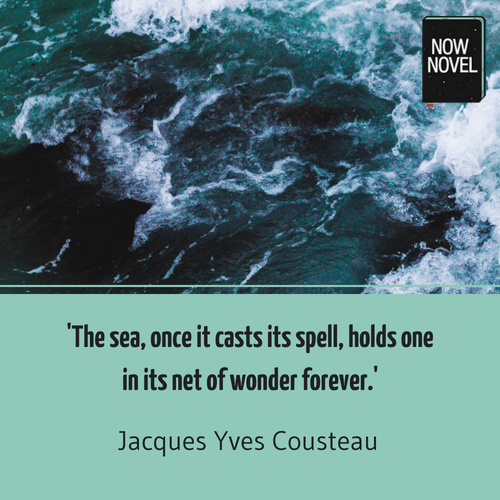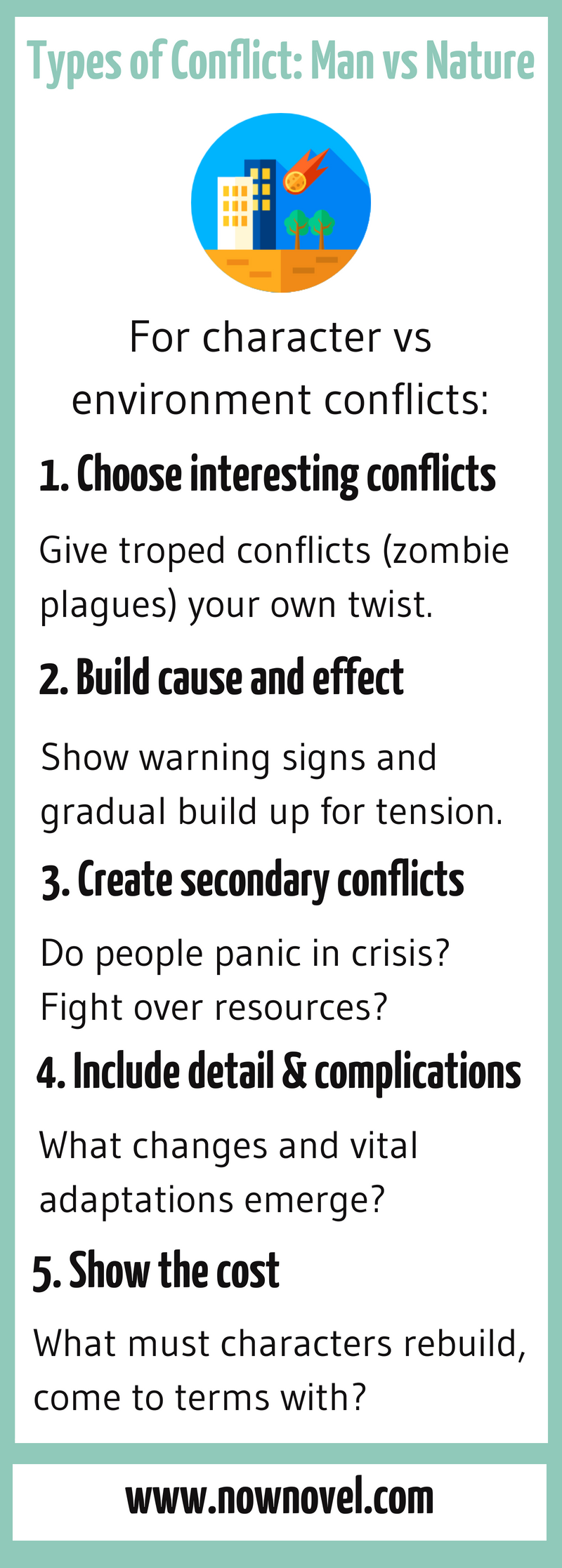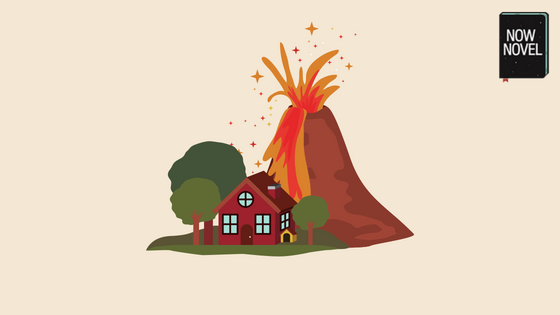Conflict in fiction is a crucial ingredient of tension and suspense. Whether it involves character vs character or character vs environment, conflict makes plots tick onward. Read tips for creating man vs nature (or person vs nature) conflict that shows characters struggling with their environments:
First: What is man vs nature conflict?
Man vs nature conflict is a staple of genres from fantasy to spy thrillers, adventure novels to science fiction. Sometimes the source of conflict is a wild ‘beast’ with inscrutable intentions (a shark, a dragon). Sometimes it’s less willful and more elemental (hurricanes, volcanoes). Whichever it is, ‘man vs nature’ shows characters confronting uncertain or hostile environments.
‘Character vs nature’ might be a better term. In a children’s book, for example, a conflict could be between a worried mouse and a terribly cold winter. The basics stay the same: How will a character co-exist with, overcome or survive a challenging setting?
Classic examples of man vs nature conflicts include Peter Benchley’s thriller Jaws (1974).In the survival novel that inspired Spielberg’s iconic movie adaptation, a predatory great white shark wreaks havoc.
Margaret Atwood’s dystopian novel Oryx and Crake (2003) imagines a world blighted by inhumane corporate and scientific practice. (A dystopian novel, for readers unfamiliar with the term, involves ‘An imagined state or society in which there is great suffering or injustice, typically one that is totalitarian or post-apocalyptic.’ The word comes from the prefix ‘dys’ meaning ‘bad’or ‘non-‘ (e.g. ‘dysfunctional’) and topos meaning ‘place’.)
Human vs nature conflicts are especially common in dystopian novels that imagine how reckless/selfish behaviour affects the natural world. They commonly explore the prices we pay for being mindless or unaware about our environment.
Now that we’ve unpacked the meaning of the term, here are some tips for using this conflict type:
1. Choose interesting man vs nature conflicts
Zombie-creating plague epidemics abound, particularly in screenplays. This doesn’t mean you can’t use this type of man vs nature conflict. Yet try to choose conflicts that aren’t entirely clichéd for your genre. If you find you’re treading in cliché territory, find ways to turn overused environmental conflicts upside down. Ask: What is unusual – or unexpected or fascinating – about this specific plague? How is it different to similar examples in fiction or film?
Make your character vs environment conflicts intriguing by building rising action. You can do this by gradually revealing cause and effect:

2. Build cause and effect
In ‘man vs environment’ conflict, the gradual revelation of the cause behind the conflict may shock or surprise. This is especially so in dystopian novels such as Oryx and Crake where characters themselves are behind the destruction or conflict. Atwood’s gradual revelation shows reckless, unethical action carried out by a main character’s former childhood friend. The slow reveal thus provides gradual information about characters’ backstories, alongside Atwood’s world’s natural history.
Conflicts between characters and their environments don’t necessarily result from their own malicious or neglectful actions, of course. Perhaps your characters are caught up in a devastating storm they have absolutely no power over. Use warning signs – darkening clouds, creatures scurrying for shelter – to create gripping build-up.
When building an arc of cause and effect in a man vs nature story, plan:
- Whether the conflict is natural or self-made: Is the environmental challenge or threat the result of nature’s inscrutable will or indifference? Or the result of calculated human action?
- How major and minor characters respond: A politician might use a storm to push a specific agenda (for example, by stirring fear of migrants looking for shelter). Others might simply be focused on packing their cars to their ceilings and outracing the storm
- Ways characters could overcome or neutralize the threat: Do characters have any power over the situation? Or (like in a natural disaster) do they have to adapt to survive?
Think about reasons behind (and possible responses to) environmental dangers and obstacles. This will help you create a cohesive story where readers see the chains of cause and effect driving plot clearly.
3. Create secondary, related conflicts
Often, in fiction as in life, conflict begets conflict. If, for example, a small city has an impending crisis due to a nuclear reactor meltdown, how might this stoke other tensions?
Characters may squabble over things usually taken for granted, for example. A tin of food, a seat on the (usually much emptier) inner-city bus. When the main conflict of a story is man vs nature, think about how it could stoke other challenges.
A person vs environment conflict can also be the minor, secondary plot point that serves an important function in your story. For example, two co-workers who hate each other in a romance novel might be grounded at the airport due to adverse weather conditions. Initially sulking in silence, they might gradually strike up a conversation and find mutual comfort and relief in their shared experience. Person vs nature conflicts are useful for drawing characters together as well as firing up their existing tensions.

4. Include detail and secondary complications
The best stories involving person vs environment conflicts pay attention to detail. For example, in Margaret Atwood’s novel The Year of the Flood, which continues in the same world as Oryx and Crake, the author creates abundant detail, such as the way her environment affects people’s lifestyles. There are multi-colored sheep called Mo’Hair, bred to be shorn to make human hair wigs.
Atwood also creates a chain of restaurants called ‘Rarity’ that specializes in serving meat from rare and endangered animals. Details such as these imagine the real-world effects when the natural world is decimated, they imagine how characters adapt. The details are believable because they show that there are people who will exploit any situation for personal gain, and this makes sense given that human selfishness and shortsightedness (in Atwood’s cycle) are the causes underlying environmental challenges in the first place.
Secondary complications stemming from a primary struggles against their environment give characters additional challenges that make their stories more tense and suspensful. In The Year of the Flood (2009), Atwood includes various street gangs as well as religious groups that emerge directly from the post-apocalyptic context. These details create secondary complications – cultural tensions – that add complexity and a sense of ‘reality’. Even in a state of environmental collapse, differences remain in how people engage with each other and their surroundings.
5. Show the cost of the conflict
As with all other types of conflict, person vs nature conflicts in stories make the biggest impact when the reader senses their cost. One of the reasons the survival film 127 hours (based on a true story) is so compelling is that the lead character (played by James Franco) has to saw his own arm free from a rock face in order to escape a climbing accident.
Here, the conflict of intrepid character vs indifferent environment has a real, felt cost. It brings home one of this story type’s important ideas: the indifference of ‘the wild’. Nature and the environment don’t care for where we build our homes or choose to go adventuring. This sense of the unpredictability of place, of nature, is part of what makes person vs nature conflicts inherently suspenseful and tense.
The cost of person vs nature might be that certain species of animals are wiped out (like in Atwood’s story cycle). Or else characters (like the courageous climber) have to pay a very personal cost.
Werner Hertzog’s documentary film Grizzly Man is iconic in large part because the subject of the documentary, Timothy Treadwell, was eaten by grizzly bears after spending 35, 000 hours with them over 13 years in Katmai National park. Here again, we see the price a person was willing to pay for their love of an aspect of the natural environment, and the fact Treadwell willingly put himself in a situation where he met a grisly (no pun intended) end reminds us how intriguing as well as humbling this type of conflict in stories can be.
Get help brainstorming and developing the core conflicts in your own story – join Now Novel.


11 replies on “6 intriguing conflict types in fiction: Man vs nature”
This is a nice list, but I only see five points, where the title shows there are six.
Hi Leto, thanks for the catch! This is a single subtopic focus on one of the six types of story conflict we’ve described here: https://www.nownovel.com/blog/what-is-story-conflict-examples/. That’s what the 6 in the title refers to. I hope that clarifies.
What is the man Vs nature conflict in Jules Verne novel journey to the centre of the earth and the mysterious Island and how it workout?
Hi Frielisa, I honestly haven’t read that novel myself (JttCoTE), but from what I gather from reading up about the core plot details, there are several man vs nature conflicts. For one, to proceed to the center, they need to enter the crater which a mountain peak’s shadow touches according to deciphered runes, yet cloudy weather prevents their progress initially (so that would be adverse weather affecting the team’s progression).
There are further conflicts once they descend towards the center, including: ‘a chamber filled with firedamp, and steep-sided wells around the “path”. After taking a wrong turn, they run out of water and Axel almost dies, but Hans taps into a neighbouring subterranean river.’
So conflicts include environmental hazards one would expect of unfamiliar terrain, such as dangers of accident and injury as well a scarcity of key resources such as water. I hope that helps!
I’d suggest reading the books through and noting any conflicts as they occur to really catch them all.
I need a man vs nature book and some examples
Hi Kyle, thank you for asking that. Any book with a survival element would fit in this category, for example The Lord of the Flies by William Golding has aspects of this type of conflict (in the children having to forage for food supplies when stranded on an island). In any story where nature is a potential adversary, this would be the case, such as in Michael Crichton’s Jurassic Park where genetic engineering leads to dinosaurs being brought back to modern times and running rampage.
could you please explain man vs nature conflict in beowulf?
Hi Udoy, with pleasure. I haven’t read Beowulf myself, but Literary Devices says: ‘The Old English epic poem Beowulf is the tale of the eponymous hero who must defeat three monsters. These monsters include Grendel, Grendel’s mother, and a dragon. The three monsters are not human and represent the fears that the Anglo-Saxons had about the natural world and its ability to destroy humanity.’
I can’t vouch for how nuanced or accurate this reading of the conflict is, not having read the book, but this is one reading (and would make sense given that in the time Beowulf was written, nature would have been a bigger unknown and/or threat to humanity than the modern day, when one could argue humans are a far bigger threat to nature). I hope this helps!
Why is the Person vs. Nature conflict important?
Hi Peter, thank you for your question. There are many possible ways to answer it.
Historically, person vs nature conflicts in stories have expressed human societies’ unease about the limits of what we know about the natural world and our environments (e.g. the mythos of the Kraken, or tales of adventure such as Twenty Thousand Leagues Under the Sea by Jules Verne), and many more modern works show concern for the impact we have on the natural world (for example, Margaret Atwood’s Oryx and Crake which explores a dystopian world that has become almost uninhabitable due to greed, science without ethics and bad stewardship of natural resources).
I would say it’s important because the natural world is something we are so dependent upon as a species, yet something that is often mysterious to us in that we cannot always immediately see the consequences of our actions within and upon it. Yet these actions do have rippling effects (for example, litter cast down in the street may wind up injuring an animal many miles away). So person vs nature conflicts often arise out of characters not fully understanding their environment or what consequences could arise from their treatment of it or relationship to it.
I’ve heard that there’s specific environments the character would be against like the well known character vs nature
I don’t know the other two.